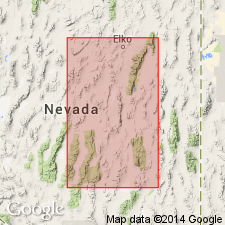
- Usage in publication:
-
- Sadler Ranch Formation
- Modifications:
-
- Named
- Biostratigraphic dating
- AAPG geologic province:
-
- Great Basin province
Summary:
Unit is named the Sadler Ranch Formation. Previously described as the middle, crinoidal part of the Union Mountain Formation by Carlisle and others (1957). Crops out along the eastern flank of the Sulphur Spring Range, at Table Mountain in the Mahogany Hills, Modoc Peak, Lone Mountain, and Union Mountain, Eureka Co., NV. Is divided into lower and upper dolomites and a middle crinoidal dolomite. Lower unit is moderately well-bedded, medium- to thick-bedded, and finely crystalline, yellowish-gray- to olive-gray-weathering, olive-gray to brownish-black dolomite; middle crinoidal dolomite is crinoidal packstone; upper dolomite is similar to the lower dolomite. Was deposited in a shallow, near-shore, carbonate shelf and slope environment. Abruptly overlies the Bartine Limestone Member of the Coils Creek Member of the McColley Canyon Formation; conformably underlies the coarse crystalline member of the Oxyoke Canyon Formation. Thickness is 124 m at the type section. Age is Early and Middle Devonian based on the presence of fossils [conodonts]. Conodont zonation indicates that the Lower Devonian-Middle Devonian boundary occurs within the unit. (B1565)
Source: GNU records (USGS DDS-6; Menlo GNULEX).
For more information, please contact Nancy Stamm, Geologic Names Committee Secretary.
Asterisk (*) indicates published by U.S. Geological Survey authors.
"No current usage" (†) implies that a name has been abandoned or has fallen into disuse. Former usage and, if known, replacement name given in parentheses ( ).
Slash (/) indicates name conflicts with nomenclatural guidelines (CSN, 1933; ACSN, 1961, 1970; NACSN, 1983, 2005, 2021). May be explained within brackets ([ ]).

